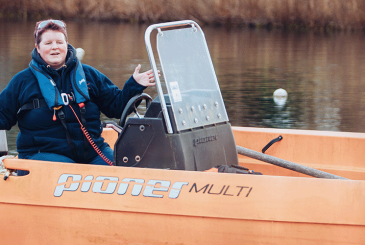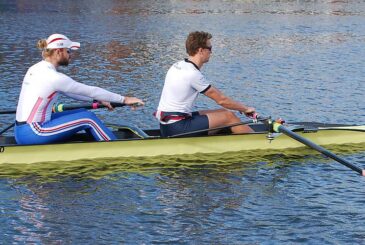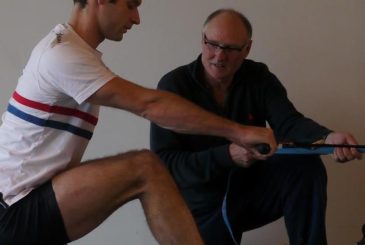Understanding biomechanics – the description, detailed analysis and assessment of human movement of the rowing stroke – can make all the difference in unlocking the speed you’ve been chasing. Kieran Clark introduces the world of biomechanics in rowing.
You miss what you don’t measure. Good erg numbers and good coaching by eye were previously the only tools that were needed to create fast crews. However, nowadays there are more and more ways in which athletes and coaches at every level can measure the power rowers are transferring to the boat, how they are moving, and how they affect the movement – and therefore the speed – of the boat. These are key elements of the British Rowing Technical Model.
The power equation
In very basic terms, the speed the boat travels comes from the power produced and transmitted by the rower to move their body mass, the boat and oars (referred to as the ‘rower-boat system’) through the water.
It is important to consider the whole system when measuring anything, as making a change in one phase or aspect of the stroke will invariably have an effect somewhere else.
Force x Length/Time: The power equation
Power is created and measured as:
- The force applied by the rower
- The length of their stroke
- The time taken to complete the stroke (60 divided by strokes per minute). For example if the stroke rate is 30, then the stroke is completed in 2 seconds.
We can calculate this with the following equation:
Power = Force x Length
Time
The effect of power on boat speed
As we’ve said already, power is the fuel for the rower-boat system. The more power you generate, the faster your boat can go.
However, the extent to which the power produced by the rower results in boat speed is dictated by the level of efficiency. This is the ratio of ‘power out’ to ‘power in’ – in other words, how much of the physical and physiological effort produced by the rower and applied to the system is ultimately transferred to move the system forwards.
Rowing power is different to erg power – it depends on technique and how the work is applied. So whilst athletes who generate high erg power have the potential to replicate that in the boat, it is possible that a less powerful, smaller rower can move a boat faster than a more powerful, larger one.
Peak force and rate of force development
Peak force is the maximum force you apply at a point during the stroke. This is usually around 15-20 degrees before the blade is perpendicular to the boat. Matching your peak force to the correct angle of the blade ensures that you don’t apply force too early, or too late, both of which could result in a lower boat speed.
However, there’s more to this than the raw size of your peak force and when it’s applied. How quickly you reach that peak force – known as the rate of force development – matters as well. Rapid force development indicates a well connected and leg driven start to your stroke, minimising energy loss.
Sequencing and coordination: Moving as one
Compared with single sculling, moving crew boats quickly isn’t all about power; it’s a choreographed dance of body parts working in harmony.
When developing a fast crew, it is important to ensure that the rowers are giving the boat a single message rather than two, four or eight different ones. Efficiency in crews depends on everyone applying the various forces and movements in the stroke cycle of drive and recovery at the same time.
Key measures of sequencing and coordination are:
- Rate of force development
- Catch and finish angles
- Drive time
- Peak force
- Leg speed
- Trunk speed
- Handle speed
- Hull acceleration and deceleration.
Importance of effective arc vs overall arc
Your overall arc is the total distance in degrees from the catch angle to the finish angle. Both of these are measured from the ‘line of work’ (when the blade shaft is perpendicular to the side of the boat). For example, in a sculling boat, if your catch angle is 65 degrees and your finish angle is 45 degrees relative to the perpendicular, then your total arc is 110 degrees.
Discrepancies at the catch and finish are both measured as ‘slip’, which is how far the blade travels without there being a minimum force going through the pin (the threshold for this can be adjusted on most telemetry systems). This essentially measures how much of your overall arc you spend actually connected to the water.
Your effective arc is your overall arc, minus your catch and finish slip.
For example, if the same sculler above had a slip of 9 degrees at the catch and 14 degrees at the finish, then can use these figures to work out the effective arc.
So in this case effective arc is 110 – (9 +14) = 87 degrees.
Measuring power vs boat speed: The benefits
Measuring boat speed alone simply tells you the outcome of what the sculler or crew is doing – you have no idea what’s causing any changes in performance.
By measuring power and boat speed, along with the variable of stroke rate, you can quantify the difference that power increase or decrease is making to your boat speed. Once that relationship between power and boat speed is broken down, you can look at how that happened. For example, did you reduce your length or effective length? Did your leg speed decrease? Did you lose acceleration on the hull?
Conclusion
Using biomechanics to unlock speed first requires an understanding of the movements and forces involved in the stroke. By integrating systems from Peach Innovations, BioRow and NK EmPower to identify and measure these forces, coaches and athletes can seek to identify what to improve, how to improve it and how those targets affect their boat speed.
Rigging
For practical guidance on how to rig boats to optimise arcs and other key biomechanics measures, Visit the Rigging section of RowHow.
Photo: AllMarkOne.










